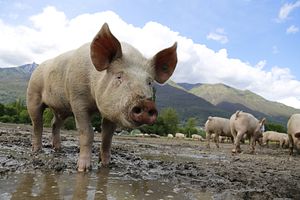Some 3 million pigs have been slaughtered in Vietnam since African swine fever was detected in February, making Vietnam the first Southeast Asian country to report an outbreak of a virus that has been devastating Chinese farmers for nearly a year.
The disease, which is harmless to humans but usually fatal to pigs, has spread rapidly. Only one of 63 Vietnamese provinces remained unaffected at the time of writing. Neighboring Cambodia confirmed its first outbreak in April; Laos followed in June. Thailand, one of Asia’s top pork producers, is poised for an outbreak.
“It’s just a matter of time,” says Dirk Pfeiffer, a professor in veterinary epidemiology at the City University of Hong Kong, about the likelihood of the virus spreading to other countries in the region.
He stands by his earlier assessment of the epidemic as the world’s biggest animal disease outbreak. From the decimation of pig populations to rising pork prices and job losses in China and the knock-on effect on global pork industry shares, the crisis “has sent ripples across most countries,” Pfeiffer told The Diplomat.
Vietnam, which has culled around 10 percent of its pigs to stop the disease spreading, is the second worst-hit country in Asia. In May the government announced it would mobilize the military to combat swine fever. The prime minister has also urged citizens to fight the virus like they would a foreign invader.
The war cry makes sense when you see how far pork is enmeshed into the cultural and economic fabric of the nation. Vietnam has one of the highest rates of pork consumption per capita worldwide — the meat is a core part of the Vietnamese diet, as it is in neighboring China. The pork industry is valued at around $4 billion, accounting for nearly 10 percent of Vietnam’s agricultural sector. In June, local media said the epidemic had already cost Vietnam’s government $154 million.
The crisis is hitting smallholder farmers, who produce most of the country’s pork, the hardest. Earlier in July the UN’s Food and Agriculture Organization (FAO) warned that the virus was threatening the livelihood and food security of millions of people in Southeast and East Asia, particularly small-scale pig farmers.
Vietnam is compensating farmers at 80 percent of the market price for each pig they have to cull. But payouts need to be more “timely” to incentivize reporting, said Dr. Hu Suk Lee, a scientist at the International Livestock Research Institute (ILRI) in Hanoi. Some farmers are selling off infected pigs rather than informing authorities. Others who have lost their herds are worried about the time it will take “to build valuable breeding stock again,” said Dr. Fred Unger, another ILRI scientist.
Swine fever was first detected outside Africa in 1957 when it was reported in Portugal. It has also travelled to other parts of the world, including the Caribbean and Brazil. Most of these outbreaks were eventually eradicated. Then, around 12 years ago, the disease re-emerged in Europe. But the virus has spread most rapidly in Asia, say experts, since it was found last year in China.
International coordination has had to rise to the massive challenge of containing the disease. The FAO is reported to have commended the efforts between governments and companies in Southeast Asia’s pork industry. But there have been concerns about under-reporting, particularly in China.
A few weeks ago, however, there was a rare admission by the Chinese government of “weaknesses” in the handling of the crisis. It’s a significant shift that researchers think is a positive move toward the transparency and trust required to manage a crisis of this scale. Ultimately, China — the world’s top hog producer and pork consumer — is where the swine fever battle has to be won.
There is presently no cure for the disease and a vaccine is unlikely to enter the market for a few years, said Dr. Linda Dixon, an African swine fever expert at the Pirbright Institute, a research center for the study of infectious diseases in farm animals. The disease is likely to persist in Asia for some years, she says, so “it’s also a wake-up call for countries to change pig farming practices and improve contingency planning.”
Dr. Lee from ILRI also spoke of the need for systemic change. “We need better biosecurity measures to reduce the chances of viruses spreading. Most smallholders have limited capacity to implement suitable biosecurity measures, while large farms have stronger biosecurity. I think we should strengthen the biosecurity of smallholders and gradually move to medium and large-scale farms.”
Even before swine fever hit Asia, China’s government was talking about shifting toward large-scale industrial pig farming. The epidemic seems to be speeding up that move.
Pfeiffer thinks the smaller farms that currently dominate Asian pig farming are likely to disappear in the coming years. “We can’t have it that anyone can start livestock farming. Though that change in mindset is very difficult,” he says. “But it’s not just about industrialized farming. It’s also about animal welfare. The focus should be on biosecurity and good husbandry conditions, not the size of farms,” he added.
There are important concerns about what such a shift might mean for small-scale farmers who depend on rearing pigs for their livelihoods. Dixon thinks that “if simple biosecurity measures are followed, it should be possible to control disease for smaller-scale farmers to coexist with bigger ones.”
There are also key questions about the risks posed by larger farms. “The more pigs you host, the higher chance you have of infection. There’s no boundary for disease,” said Dr. Kin Wing Chan from the University of Exeter, whose research focuses on animal health.
He thinks the growing debate about the future of pig farming in Asia needs to embrace an altogether different direction. “We need to think about eating less meat and not over-producing. Intensification of animal production isn’t the solution.”

































